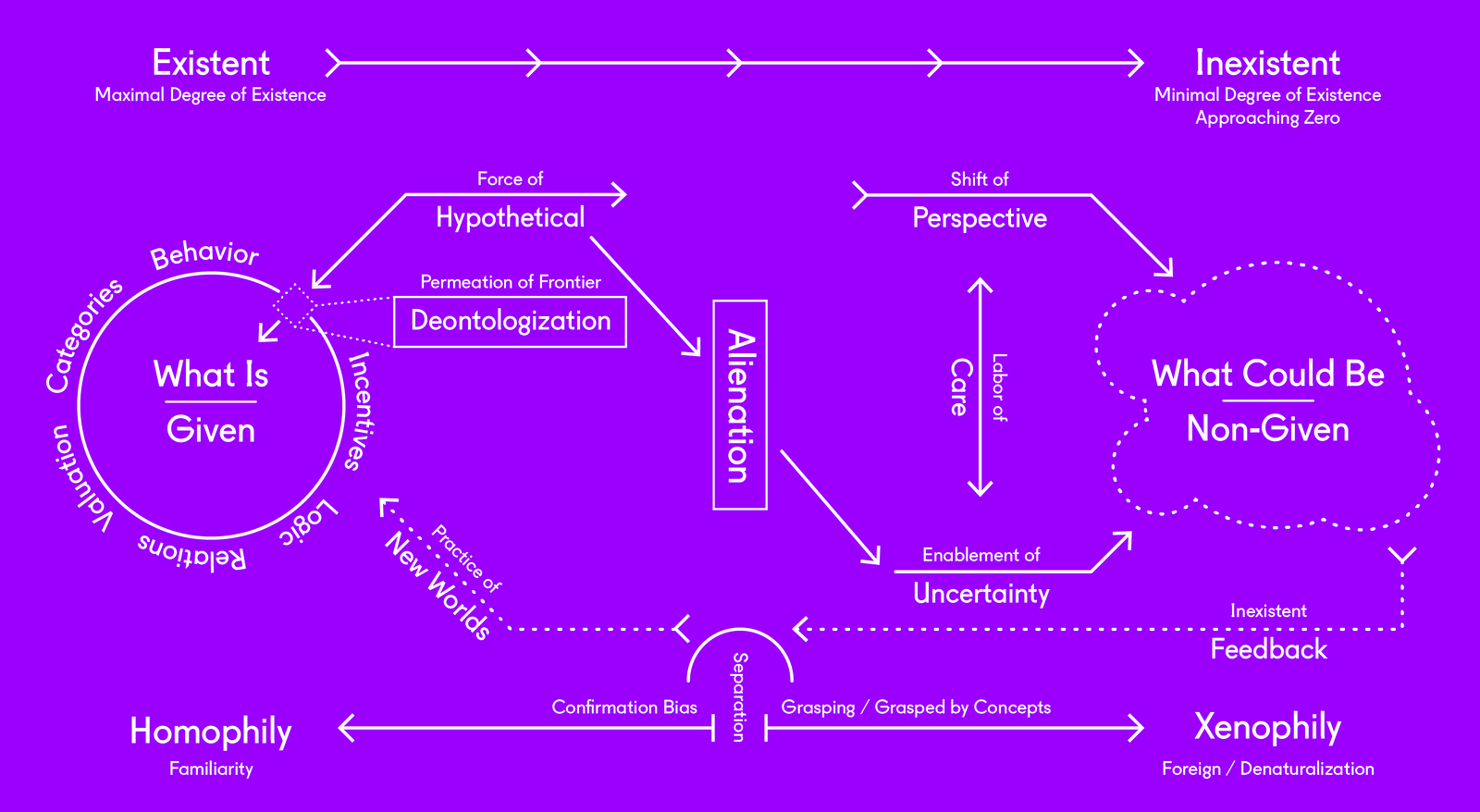There has been an excess of modesty in the feminist agendas of recent decades. Carol A. Stabile is amongst those who have been critical of an absence of systemic thinking within postmodern feminisms, remarking upon a “growing emphasis on fragmentations and single-issue politics.”1 Stabile dismisses this kind of thinking which, in “so resolutely avoiding ‘totalizing’—the bête noire of contemporary critical theory—[…] ignores or jettisons a structural analysis of capitalism.”2 The difference in scope and scale between that which is being opposed and the strategies being used to oppose it is generative of a sense of disempowerment.
On the one hand, Stabile argues, postmodern social theorists “accept the systemic nature of capitalism, as made visible in its consolidation of power and its global expansion […] Capitalism’s power as a system is therefore identified and named as a totality”; on the other hand, these theorists “celebrate local, fragmented, or partial forms of knowledge as the only forms of knowledge available” and criticize big-picture speculative thinking for its potentially oppressive tendencies or applications.3 Nancy Fraser, too, has addressed this apparent “shrinking of emancipatory vision at the fin de siècle,” linking this with “a major shift in the feminist imaginary” during the 1980s and 1990s—that is, with a move away from attempting to remake political economy (redistribution) and towards an effort at transforming culture (recognition).4
The legacies of this kind of political theorizing—legacies some might describe as “folk political”—are still being felt today, and continue to shape the perceived horizons of possibility for progressive projects.5 Yet these projects, which are frequently valuable, necessary, and effective on their own terms, are not sufficient as ends in themselves. To the extent that they are conceptualized in detachment from an ecology of other interventions, operating via a diversity of means and across a variety of scales, they cannot serve as a suitable basis for any politics seeking to contest the imaginaries of the right or to contend with the expansive hegemonic project of neoliberal capitalism. It is for this reason that Nick Srnicek and Alex Williams’s work positions itself as somewhat skeptical about fragmentations and single-issue politics, pointing out that problems such as “global exploitation, planetary climate change, rising surplus populations, [and] the repeated crises of capitalism are abstract in appearance, complex in structure, and non-localized.”6 As such, a politics based around the ideas that “the local is ethical, simpler is better, the organic is healthy, permanence is oppressive, and progress is over” is not always the best weapon in an attempt to contend with the complex technomaterial conditions of the world as it stands.7 There is a persistent kind of abstraction anxiety hanging over progressive politics; an anxiety that haunts a contemporary leftist feminism still unwilling or unable to critically reappraise the tendencies that Stabile identified in the 90s.
Recently, however, a renewed appetite for ambitious and future-oriented emancipatory politics has begun to make itself felt at the fringes of the left—and indeed, to gather momentum and popular support more broadly.8 Perhaps the most remarkable example of this tendency within philosophically-inflected political theory circles has been accelerationism, with its calls to build an “intellectual infrastructure” capable of “creating a new ideology, economic and social models, and a vision of the good to replace and surpass the emaciated ideals that rule our world today.”9 These so-called “Promethean” ideas have generated widespread interest, arguably both reflecting and contributing to the changing tenor of activist discourse. Interestingly, this term has to some extent emerged in opposition to the pejorative “folk political,” acting as a shorthand for a very different set of values and perspectives. In a recent critical piece, Alexander Galloway suggests that “Prometheanism” could be defined as “technology for humans to overcome natural limit.”10 Peter Wolfendale, meanwhile, sees it as a “politics of intervention”—one that starts from the insistence that nothing be exempted in advance from the enactment of re/visionary processes.11
Contemporary feminism, too, is picking up on this emergent mood. Nascent projects such as xenofeminism, for example, are seeking to articulate a technologically-minded counter-hegemonic gender politics fit for an era of globality, complexity, and alienation, and as such, evince a commitment to the development of more systemic approaches to oppression (reminiscent of those Promethean “perspectives of winning” which characterized strands of second wave activism).12 But is the designation “Promethean” always hospitable when it comes to these emerging feminisms? What are the connotations of this label, and what kinds of ideas does it foreground or appear to overlook? Starting with a discussion of the notion of Promethean politics sketched out by both Ray Brassier and Alberto Toscano, and critically considering its relationship to gender and labor, this essay will examine some of the artificial barriers to participation in and engagement with the Promethean project, particularly in terms of the seemingly competing demands of social reproduction. This, in turn, will lead to a consideration of some of the historical debates surrounding care work and reproductive labor within feminism, and to an analysis of the facets of those debates that encourage a re-estimation of social reproduction.
The aim of this essay is to prompt a reconsideration of the domestic not only as an object of Promethean ambition, but also as a site from which to launch emancipatory political projects. Whilst the first section considers what feminism might have to gain from seizing upon Prometheanism, the second moves on to charge Prometheanism with the task of learning from feminism.
Gendering Prometheus: Risk and Collective Politics
A Promethean politics is averse to both illusion—“the persuasion that the powerless can prevail over the powerful without concentrating and organizing their forces”—and melancholy—“the sense that emancipation is an object better mourned than desired.”13 It might, at its most general level, be characterized as a transformative, world-building, and technologically enabled emancipatory endeavor, oriented towards the future. For Ray Brassier, in “Prometheanism and its Critics,” it is “simply the claim that there is no reason to assume a predetermined limit to what we can achieve or to the ways in which we can transform ourselves and our world.”14 The implicit gender political dimensions of this are clear throughout his analysis, which frequently demonstrates a remarkable affinity with key elements of technofeminist thought—from an avowed anxiety about ceding nanotechnology, biotechnology, information technology, and cognitive science (NBIC) technologies to the champions of neoliberal capitalism, to (most obviously) an interest in synthetic life and in questioning the assumption of birth as a biological absolute. All elements of existence, including the human and its reproductive processes, are therefore positioned as mutable and as available for re-engineering.
If, as Brassier contends, the “Promethean trespass resides in making the given,” then emerging strains of feminism which privilege the synthetic over the organic, the mediated over the immediate, and technologized natureculture over an inflated idea of “the natural” might justifiably be described as examples of Promethean gender politics.15 Like the mythical Greek figure, such feminisms demonstrate an interest in the processes whereby life (both biological and social) is constructed and crafted, as well as a healthy disregard for supposedly immovable limits and an investment in the liberatory potentials of technology—that infamous “Promethean supplement.”16 Following Shulamith Firestone (a Promethean in both name and nature!), xenofeminism professes an interest in what some envision as “technology’s ultimate cultural goal: the building of the ideal in the real world,” and as such might find Prometheus to be a suitable figurehead, despite his mythical associations with arrogance, pride, and machismo.17
Indeed, several contemporary leftists have already sought to challenge the Titan’s association with these gendered forms of swagger. Toscano, for example, in reclaiming the epithet “Promethean” from Simon Critchley, declares that:
the figure of Prometheus is not, as so many critiques of Marxism have argued, the herald of some kind of disastrous hubris; Prometheus is the bearer of the open question of how we, creatures that draw their breath in gasps, can manage not to be subject to the violent prerogatives of sovereignty. The demands and prescriptions that a “Promethean” politics carries are not those of nihilistic destruction, nor are they infinite and unfulfillable; they are specific but unconditional demands made on our capacities that, although certainly limited in kind, are often more than sufficient, when concerted and composed into the action of a collective subject, to act in a principled, egalitarian and emancipatory sense.18
A Promethean politics is here depicted as founded upon answerable demands—calls to satisfy aims that are actionable and achievable, and which are neither illusory nor melancholic. Again, then, this adjective would appear to be a good fit for those ambitious and counter-hegemonic contemporary feminisms that heed Stabile’s call for a more systemic and structural analysis of classed and gendered oppression, which might effectively be combined with smaller-scale, single-issue organizing.
But feminists should not seek to take up this label without subjecting it to some careful and critical qualification. Myths have histories, after all. As Galloway notes, the Promethean story in fact includes “three moments”—the narrative concerns not only the light-fingered Prometheus, but also the neglectful Epimetheus and the gift-extending Hermes (a character identified with genericity on account of his bestowal of equality and justice to all humankind).19 However, whilst critiquing the apparent “brocialism” of the Promethean turn, and despite approvingly citing xenofeminism’s “universalism from below” as part of a more holistic account of emancipatory politics, Galloway misses one further strand of this mythical nexus—that is, the story of Pandora. We would do well to remember that Prometheus’s transgressions are depicted as leading Zeus to punish mankind via the creation of the first woman. This is the far more obvious and provocative element from a gender political perspective! Many versions of the myth present Prometheus as justifiably suspicious of Pandora—the original woman as deceptive gift—thereby rendering our trickster hero somewhat less than appropriate as an icon for feminist initiatives. We must be wary of the deep significances packed into literary allusions; rhetorical flourishes may be laden with cultural baggage. But if it seems churlish to point out that Prometheus represents both a gendered mythology and a mythology of gender, then it is perhaps less trivial to acknowledge that the kinds of Promethean activism some commentators envision present distinctly gendered barriers to political participation.
In the first place, the ability to answer “an absolute (although not infinite) demand for human emancipation” is shown to require not only the possession of certain financial, social, and cognitive resources, but also the freedom to commit oneself to undertaking a degree of personal risk in the face of potential conflict and violence.20 This freedom, I would argue, is not equally available to all people and is likely to be constrained by the obligations of, for example, reproductive labor (by which I mean the activities that nurture future workers, regenerate the current workforce, and maintain those who cannot work; in effect, the everyday tasks involved in staying alive and helping others stay alive). For Toscano, a Promethean politics which seeks to “increase effectiveness, prepare emancipation and minimize domination […] will involve considerable degrees of self-mastery, which is to say of discipline—after all, the recognition of our ‘finitude’ (or rather, our mortality) is often a powerful counter-argument to political commitment (just think of your family, think of what you could lose, and so on).” If domination is “based on the exploitation of our mortality—and especially of the cares and fears that so often prevent political mobilization,” then engagement in the Promethean endeavor (characterized here as an inherently, if not especially, self-endangering practice) must be understood as subject to certain restrictions. This is not only a matter of the responsibilities attendant upon social reproduction butting up against calls for concerted, effortful, and resource-consuming political activity (although this will remain a problem for activism of all stripes and persuasions for as long as movements ignore the role of social infrastructure in enabling involvement). It is also a question of acknowledging that, for structural reasons, anxieties in the face of absolute demands are likely to be more acute for some individuals (including, but not limited to, women) than they will be for others.
“Cares and fears,” then, are differentially distributed phenomena, and it is harder to be indifferent to one’s self-perpetuation if it is not merely the perpetuation of the self that is at stake. For some, the exhortation to “just think of your family” cannot be dismissed so easily by discipline and an effort of will in the face of familial, domestic, and other material caregiving responsibilities, and this should prompt us to reflect upon and revisit what we consider to be meaningfully political. It is worth noting that Toscano’s “plea for Prometheus” can in some ways be viewed as distinct from later accounts, such as Brassier’s, in which the connections between collective political ambition and concerns regarding personal risk are not confronted so directly. Whilst both perspectives share an assumption that one “cannot have an emancipatory politics rooted in fear,” and that one should denounce an ethos of “self-preservation at all costs,” Brassier’s characterization tends to operate at a certain remove from the idea of the socially enmeshed, fully embodied individual.21 He may declare that “a species whose only concern is its own perpetuation does not deserve to exist,” but he is not directly interested in or explicit about the lived implications of this. A dismissal of the blind prioritization of the continuation of humanity is surely easier to accept when considering the issue at a species’ level than it is when, say, considering the ongoing lives of specific vulnerable individuals dependent upon your paid and unpaid labor in order to survive and flourish.
Whilst xenofeminism might embrace the “attempt to participate in the creation of the world without having to defer to a divine blueprint,” and can enthusiastically advocate for a forward-looking counter-hegemonic technopolitics invested in re-engineering the given, it is crucial that those of us involved in the development of this project also sound a note of caution about the designation “Prometheanism.”22 As far as possible (and acknowledging that, yes, there will indeed be situations in which the demands of the collective outweigh those of the individual and her dependents), Promethean endeavor must not be positioned in such a way as to pit it against the immediate responsibilities of reproductive labor to the extent that the demands of one can only be met at the expense of the other. This kind of framing of emancipatory leftist politics repels and excludes too many with a stake in the debates, and is likely to give rise to precisely those boring and boorish militant masculinities that hostile critics have pre-emptively deemed characteristic of movements like accelerationism. It seems obvious to me that any emancipatory project worth its name must, of necessity, be a feminism. As Camille Barbagallo and Silvia Federici note, “the struggle over ‘reproduction’ is central to every other struggle and to the development of ‘self-reproducing movements,’ that is movements that do not separate political work from the activities necessary to the reproduction of our life, for no struggle is sustainable that ignores the needs, experiences, and practices that reproducing ourselves entails.”23 Furthermore, left Prometheanism betrays its impetus and ambitions for thoroughgoing social transformation if it fails to explicitly confront the full nexus of structural oppression, or to bring intersectional gender politics within its purview. “Brometheanism” indeed!
Contemporary counter-hegemonic feminisms must grasp the difficulties attendant upon demanding certain kinds of political involvement and do what it can to lower the gendered, classed, and raced barriers impeding participation. In other words, our “Promethean” politics must acknowledge that many people experience diminished personal freedom in the face of obligations to others, and that this need not diminish the importance of freedom as a goal of collective self-mastery. Individuals may operate within specific material constraints and restrictive given circumstances, but on the species level, “there is no reason to assume a predetermined limit to what we can achieve or to the ways in which we can transform ourselves and our world.”24 Further to this, xenofeminism should insist on the wrong-headedness of assumptions that position the sphere of social reproduction as little more than a check upon collective ambition and an obstacle to the answering of potentially fulfillable demands. In fact, whilst the requirements of care work certainly present complexities that demand careful navigation, this sphere of gendered labor also offers distinctive opportunities for “principled, egalitarian and emancipatory” action.25 In what follows, we will look at some of the ways in which domestic labor has been positioned by feminist thinkers, before considering whether or not spaces of domesticity might also be spaces for ambitious political thinking—thinking which exceeds the so-called “folk political.”

A model of Frances Gabe’s Self-Cleaning House. Image: Hagley Museum.

A model of Frances Gabe’s Self-Cleaning House. Image: Hagley Museum.
A model of Frances Gabe’s Self-Cleaning House. Image: Hagley Museum.
A Promethean’s Place?
It is perhaps understandable that very few aspects of social reproduction make an appearance in twenty-first century proclamations about Promethean politics. After all, there are numerous barriers to envisioning things like care work and domestic labor as positive elements in a counter-hegemonic project, and feminists themselves have historically disagreed about the role of indirectly market-mediated reproductive labor in the process of radical and emancipatory change. For Angela Y. Davis, for example, writing at the beginning of the 1980s, the tactical adjustment most likely to help overthrow oppression on the basis of gender involves getting women out of the home and into the workplace in as great a number as possible. She argues that housework is “invisible, repetitive, exhausting, unproductive, uncreative,” and that “neither women nor men should waste precious hours of their lives on work that is neither stimulating nor productive.”26 Such labor is both limited and limiting, her analysis suggests, and it is up to feminists to “call upon women to ‘leave home’ in search of outside jobs—or at least to participate in a massive campaign for decent jobs for women.”27
Part of the motivation behind Davis’s emphasis on the workplace here is an attempt to counter the atomization and privatization usually associated with the domestic dwelling. As Ellen Lupton has argued in her history of women and machine design, the rise of household appliances and domestic technologies in the mid-twentieth century “affirmed women’s roles as consumers of individual products instead of shared central services,” further fostering those forms of segregation facilitated by geographically dispersed post-war suburban housing developments.28 Work, in Davis’s analysis, is crucial for overcoming privatization and for the development of sex-class consciousness and a collective politics. Wage labor may be boring or brutal, but unlike the isolated residence, it encourages connection: “on the job, women can unite with their sisters—and indeed with their brothers—in order to challenge the capitalists at the point of production.”29
This attitude to work can also be seen to inform much of Davis’s perspective on universal basic income (or UBI). Her views on this diverge markedly from the earlier account of Firestone (another feminist with an interest in domestic arrangements), despite both agreeing on the importance of UBI as a kind of transitional demand. For Firestone, whose work on industrial automation and cybernetic communism is widely seen as both seminal and controversial, the introduction of effective workplace technologies will have far-reaching implications when it comes to gendered cultures of work. Suddenly, she argues, “we are talking about more than a fair integration into the labor force; we are talking about the obsolescence of the labor force itself through cybernation, the radical restructuring of the economy to make ‘work,’ i.e. compulsory labor, particularly alienated ‘wage’ labor, no longer necessary.”30 This transition toward increasing automation should, Firestone proposes, be supported by a UBI that will allow people to subsist in a residual money economy without having to resort to paid work.
Whilst Firestone’s The Dialectic of Sex discusses UBI as a means of subsistence at the fag end of the money economy, enabling people to live without being forced into wage labor, Davis sees it as primarily as a means to get women (particularly mothers) into the workforce, and thereby out of the home. Noting that women on welfare “have rarely demanded compensation for keeping house,” Davis claims that
Not “wages for housework” but rather “a guaranteed annual income for all” is the slogan articulating the immediate alternative they have most frequently proposed to the dehumanizing welfare system. What they want in the long run, however, is jobs and affordable public child care. The guaranteed annual income functions, therefore, as unemployment insurance pending the creation of more jobs with adequate wages along with subsidized systems of child care. 31
This version of UBI sees it as a stopgap for individual women, facilitating the process of finding suitable jobs.32 Again, then, we witness a turn away from the home and toward the traditional waged workplace as the privileged site of “Promethean” socialist activism and systemic structural analysis. However, if we are seeking to reconsider the possibilities of social reproduction, in the interests of generating a more egalitarian conception of what a contemporary Promethean politics might mean, then we need to move beyond this privileging of the conventional spaces of wage labor. Indeed, we must turn our attention to the opportunities inherent in the collective reorganization and re-imagination of domestic space.
Against Domestic Realism
The drive to get homemakers into work, it should be noted, is far from the ultimate aim of Davis’s project. She would like to see a kind of hi-tech socialization of housework, with “teams of trained and well-paid workers, moving from dwelling to dwelling, engineering technologically advanced cleaning machinery” under the instruction of the state.33 But such a vision of the individual’s emancipation from housework would, she suggests, only be realizable under socialism, and the transformation of the political and economic system must therefore be agitated for as a primary goal. Davis’s argument is that women should first become wage laborers outside of the home, in order to help bring about progressive changes in the social order, so that moves toward the de-privatization of domestic labor might take place (arguably a somewhat rigid and counter-intuitive sequencing of social transformation, given that it initially requires women to fight for a place in the very labor force their employed male comrades are struggling against).
This argument is likely to register as somewhat problematic to contemporary readers, given that we are increasingly aware of the “erasure of the border between labor time and life time”—a border that was always tenuous or non-existent for some facets of the working class.34 For many of us lucky enough to be exploited by capital—and, when one considers the majority of the current alternatives, we mostly are lucky, even as we recognize the necessity of struggling for new and better alternatives—the home frequently becomes a site at which wage labor (or unrecognized work related to wage labor) is performed. The so-called “feminization of labor,” meanwhile, means that reproductive activities once largely associated with the home “no longer function to reproduce labor-power but instead are activities that directly produce surplus-value.”35 Add to this the fact that non-unionized and precarious workers find workplace organization notoriously difficult, and the fact that many working women will pass off the unmanageable labor of social reproduction to lower paid domestic workers, and any claim for the necessity of prioritizing the conventional waged workplace is likely to come in for intense critical scrutiny.
In Davis’s work, the domestic sphere, perhaps surprisingly, appears somewhat denuded of political opportunity. Unlike the traditional spaces of waged labor, it is seen as a potential site for transformation, but not as a possible field of operations for working to bring about such transformations; it is always figure, never ground. It is interesting to note that—despite quoting from the work of the visionary late nineteenth century home economist and feminist futurist Charlotte Perkins Gilman—Davis appears somewhat unimaginative in her understanding of what the home is or might be. Whereas Gilman argued for new domestic arrangements (including feminist housing complexes with shared cooking facilities) to help promote the evolution of socialism, Davis’s thinking is largely restricted to the conventional privatized dwelling (albeit one made newly subject to socialized, technologized, and state-organized housework).36 For her, it would seem, the meaning and the shape of the home has been set, and can no longer be seen as mutable.
Indeed, even many of the activists involved in the ambitious Wages for Housework project—a campaign avowedly invested in finding ways to agitate from beyond the traditional spaces of waged work—at times fail to think beyond the notion of domestic space as privatized single-family units. In her 1975 essay “Wages Against Housework,” for example, Silvia Federici explicitly seeks to “draw a line” between her position and “the proposed socialization and collectivization of housework,” which she believes risks devolving too much power to the state.37 Elements of the social and spatial structures associated with reproductive labor are here once again largely passed over as territories for radical transformation. The organization of the home itself—a space that is arguably both reflective of and influential upon elements of human experience such as economic relations and sexual norms—does not appear to be visible as a site of potential change.
This unwillingness or inability to re-imagine the spaces of social reproduction relates to Dolores Hayden’s claims in her excellent history of feminist home design and community planning, The Grand Domestic Revolution. In this text, Hayden gives an overview of some of the various experiments in domestic design and organization undertaken from the mid-1800s through to the 1930s. Despite this genealogy of domestic innovation, however, Hayden notes that feminists have, in more recent years, come to accept the “spatial design of the isolated home, which [requires] an inordinate amount of human time and energy to sustain, as an inevitable part of domestic life.”38 This is evidence of what I propose to call “domestic realism” (so named after Mark Fisher’s Capitalist Realism, rather than the literary genre)—that is, of the stubbornness or obstinacy of domestic imaginaries, even in the face of otherwise extensive visions of socio-technical overhaul. Domestic realism names the phenomenon by which the isolated and individualized small dwelling (and the concomitant privatization of household labor) becomes so accepted and commonplace that it is nearly impossible to imagine life being organized in any other way. That this occurs despite many people’s lived experiences of the pressures and difficulties attendant upon reproductive labour as it is currently organized only serves to make it more remarkable.
The home, to use the language of Prometheanism, comes to be positioned as an un-remakeable given. As Hayden’s work makes clear, however, there are many possible forms of domestic arrangement—both spatial and relational—aside from the atomized and depoliticized family space that Davis has in mind. The material feminists of Hayden’s study
saw that many decisions about the organization of future society were being incorporated into the built environment. Therefore, they identified spatial transformation of the domestic workplace under women’s control as a key issue linking campaigns for social equality, economic justice, and environmental reform.39
These feminists devised various approaches to rethinking domesticity, such as collective residential neighborhoods featuring cooperative housekeeping centers and kitchen-less houses, apartment hotels with communal dining rooms and spaces for shared childcare, and courtyard housing blocks with a common laundry, parlor, and library (as well as spaces for food preparation).40 Indeed, these interventions—or something like them—obtained material expression in the socialist housing of “Red Vienna”, designed and built as part of a radical program of municipal reforms instigated by the Social Democratic city council between 1919 and 1934. Here, “workers’ dwellings were incorporated with kindergartens, libraries, medical and dental clinics, laundries, workshops, theatres, co-operative stores, public gardens, sports facilities, and a wide range of other public facilities.”41
Whilst not explicitly framed as a feminist measure, the gender political potential of these attempts at “shaping a new form of socialized proletarian life” are both apparent and tantalizing.42 Historians of urban planning have been quite clear about the limitations and failures of this particular Austrian initiative, and critics such as Eve Blau have taken pains to delegitimize the idea of an architectural quick-fix, stressing instead the inexorable connections between spatial and social relations. However, the manner in which these examples prize open the home as a site for reappraisal nevertheless has interesting implications for Promethean politics. Practical suggestions for eliminating “domestic drudgery through design” abounded at the beginning of the twentieth century, as socialists and feminists alike imagined new technologies that would facilitate a less oppressive, exhausting, and time-consuming household.43
That feminists of this period sought to intervene within the material hegemonies of gendered life before concentrating on agitating for greater male involvement in reproductive labor says something about the intractability of those social roles that differentially disadvantage non-men. In many re-imagined domestic spaces, the material environment was recognized as a tool to help encourage collective housekeeping. The sharing and specialization of domestic labor that this helped to bring about was designed to reduce the burden placed upon individual women and to enable them to cut costs whilst reclaiming a portion of their time, either for other forms of work or for the pursuit of personal, civic, and political interests. Admittedly, many of these projects were driven by bourgeois home economists (such as Gilman). Many people belonging to the urban working classes would of course have had far less positive experiences of co-living and shared facilities, given late nineteenth and early twentieth century tenement conditions. However, the implications of these projects often reached beyond the middle classes. Cooperative domestic arrangements in, for example, the Chicago settlements of the 1890s worked to facilitate the organization of trade unions and helped to discourage strike breaking.44
A number of the historical examples included with Hayden’s text were purely speculative or overtly fictional, and most never made it past the planning stage, but a number were (at least partially) realized. Of those that did become a concrete reality, the socialization of domestic labor that they involved provided a justification for extensive investment in home technologies. Hayden notes, for example, that certain American communes in the 1860s enjoyed what were at that point cutting edge innovations such as “gas light, steam baths, and steam heat,” leading one nineteenth century journalist to declare that “a communist’s life is full of devices for ease and comfort.”45 Here, we find the seeds of a project, grounded in lived realities, that reaches beyond the aspersions cast upon the “folk political”—a transformative and technologically enabled enterprise that attends to important issues around gendered oppression and aims to make space within the conditions of the present for a more emancipatory feminist future. Indeed, only a truly Promethean project can be fit to dis-embed something as seemingly intractable as domestic realism. What can contemporary feminisms (and other so-called Prometheanisms) hope to inherit, absorb, and repurpose from this tradition of socialist and feminist practice?

US Patent 4428085 for a Self-cleaning building construction, filed April 21, 1980, sheet one of six. Fig. 1: Floor plan of a self-cleaning building construction.

US Patent 4428085 for a Self-cleaning building construction, filed April 21, 1980, sheet two of six. Fig. 2: Partial cross-sectional view of water distribution means; Fig. 3: View looking upward toward said water distribution means; Fig. 4: Transverse cross-sectional view of baseboard means according to the present invention for delivering water cleaning liquid, drying air, and heating air; Fig. 5: Partially broke away view taken at 5-5 in Fig. 4; Fig. 6: Transverse cross-sectional view of a door sill construction; Fig. 7: Cross-sectional view illustrating means for providing a particular slope for the self-cleaning building construction; Fig. 13: Top view of the Fig. 12 washbasin.

US Patent 4428085 for a Self-cleaning building construction, filed April 21, 1980, sheet three of six. Fig. 8 is a cross-sectional view of a closet including a clothes freshener; Fig. 9 is a partially broken away horizontal cross-sectional view of the clothes freshener area in Fig. 8; Fig. 10 is a view of clothes hanger adapted for use in the Fig. 8 closet and clothes freshener; Fig. 11 is a partially broken away, perspective view of a self-cleaning bathtub; Fig. 12 is an elevational view of a washbasin.

US Patent 4428085 for a Self-cleaning building construction, filed April 21, 1980, sheet four of six. Fig. 14 is a vertical cross-sectional view of a cupboard dishwasher; Fig. 15 is a perspective view of a dish rack employed in the Fig. 14 cupboard dishwasher; Fig. 16 is a plan view of a grillwork shelf employed in the building construction; Fig. 18 is a view of a timing apparatus; Fig. 19 is a cross-sectional view of the FIG. 18 apparatus taken at 19-19 in Fig. 18.

US Patent 4428085 for a Self-cleaning building construction, filed April 21, 1980, sheet five of six. Fig. 17: Diagrammatic representation of plumbing and heating connections for the building construction; Fig. 25: Elevational view, partially in cross section, of a dry toilet; Fig. 26: Top view, partially broken away and partially in cross section, of the Fig. 25 dry toilet; Fig. 27: Pespective view of a liner employed in the Fig. 25 dry toilet.

US Patent 4428085 for a Self-cleaning building construction, filed April 21, 1980, sheet six of six. Fig. 20: Elevational view of a window wall; Fig. 21: Cross-sectional view taken at 21-21 in Fig. 20, comprising a cross-sectional view of a window glide; Fig. 22: Cross-sectional view taken at 22-22 in Fig. 21; Fig. 23: Elevational view of an alternative window wall.
US Patent 4428085 for a Self-cleaning building construction, filed April 21, 1980, sheet one of six. Fig. 1: Floor plan of a self-cleaning building construction.
Towards a Promethean Feminism
As the above discussion suggests, the familial and the domestic should not be seen merely as a drag upon or a barrier to a boys’-own Prometheanism, but must instead be viewed as an important field upon which an ambitious and emancipatory political endeavor might be enacted. That is to say, domestic arrangements can evidently foster and facilitate the kind of collective politics that Angela Davis sees as coming primarily from the conventional capitalist workplace. In de-prioritizing the home to some extent, Davis arguably risks naturalizing current domestic arrangements, inadvertently presenting alterable and contingent forms of organization as unassailable, immutable, and permanent—or at least as more permanent than other kinds of social structures. As such, they come to represent a form of material hegemony so deeply embedded that it can be neither looked past nor seen through.
This is particularly ironic, given the long-standing status of the household as a locus of political mobilization within Black communities in the United States. Within these communities, the enforced mutability of the family—both as a legacy of slavery and as a consequence of neoliberal economic precarity—has rendered the potential instability of naturalized models of domesticity painfully apparent. As such, Davis’s analysis speaks to the distinctively raced histories of relations of social reproduction. The bourgeois family form must be recognised as a culturally dominant ideal from which people of color (as well as many queer, gender non-conforming, and working class people) have historically been structurally excluded. Considering the ways in which access to the family has been differentially distributed according to race, class, and sexuality allows us to appreciate its potentially variegated place within situated struggles. Nevertheless, we must strive to find intersectional and emancipatory mechanisms for collective social survival that do not require us to reify contemporary inegalitarian domestic relations. In other words, we must not work to overthrow one set of oppressions with the explicit aim of replacing it with another.
When it comes to thinking about Promethean projects and the home, twenty-first century feminists would do better to turn their attentions to Shulamith Firestone, in whose work we can detect a concerted effort to contest domestic realism and to contend for the sites of reproduction (in both its social and biological forms). As with contemporary Prometheans and xenofeminists, Firestone is interested in the politics of generation, the technologically enabled manipulation of birth, and the refusal of sexual reproduction as an immovable given. “Pregnancy” Firestone argues, “is the temporary deformation of the body of the individual for the sake of the species”; in the late twentieth century, however, the development of increasingly sophisticated means of artificial reproduction have “created real pre-conditions for overthrowing these oppressive “natural” conditions, along with their cultural reinforcements.”46 It is perhaps to be expected, given this perspective, that she has plenty to say on the topic of the gendered division of labor in the home. When it comes to domestic technologies, Firestone’s comments are brief, but in keeping with her avowed positions on industrial automation and assisted reproduction, she speculates that, in a future radical feminist society, “cybernation would take care of most domestic chores.”47
The idea that automation in the home might eradicate many of the daily burdens of housekeeping is one that has long been promoted by consumer capitalism, and Firestone’s techno-optimism here affirms her critics’ suspicions that she neglects the socio-political. In Nina Power’s words, “While the Soviets proposed the socialization of housework and childcare, Firestone leaves almost everything to the machine, which will fix housework, reproduction, and the working day.”48 It is certainly important that we follow these critics in questioning any kind of blind faith in domestic technologies, for there are numerous barriers to machines becoming the emancipatory force that Firestone envisions. As Davis notes, “the structural separation of the public economy of capitalism and the private economy of the home has been continually reinforced by the obstinate primitiveness of household labor. Despite the proliferation of gadgets for the home, domestic work has remained qualitatively unaffected by the technological advances brought on by industrial capitalism.”49 A healthy disregard for the perceived necessity and moral value of drudgery is to be encouraged, but Prometheanism must aspire to avoid illusion just as much as melancholy.
However, Firestone’s response to the gendered oppressions of reproductive labor includes a marked emphasis upon cooperation and cohabitation beyond the confines of the traditional family structure—an emphasis she shares with many of the ambitious projects outlined in The Grand Domestic Revolution. Indeed, the household as a collective is an important element of Firestone’s politics, and a lot of her attitudes regarding the dismantling of the family would lend themselves to co-operative housekeeping. A household, as a social unit composed of a “large grouping of people living together for an unspecified time, with no specified set of interpersonal relations,” would not retain the “division of labor by sex” typical of the unit of the family.50 Contra Power’s comment about her disinterest in non-cybernetic solutions to the challenges of the domestic, Firestone does reflect upon the collectivization of domestic chores, stating that “the larger family-sized group (twelve to fifteen people) would be more practical—the waste and repetition of the duplicate nuclear family unit would be avoided, e.g., as in shopping for three or four people.”51 Domestic technologies, like cybernation and assisted reproduction, do not exist in a vacuum; instead, they are viewed as requiring concomitant advances in social and interpersonal relations if the feminist socialist revolution that Firestone envisions is to be realized.
Whilst we may not agree with all of the substantive content of Firestone’s idiosyncratic envisioning of a feminist future (the racial politics of The Dialectic of Sex are particularly problematic, for example, as is the implication that there is an absolute end point of perfect synthesis for gendered humanity), there is much to take up from her expansive, ambitious, and technologically-minded feminism. The changes associated with the re-imagining of social reproduction, for example, are not seen as an endpoint in and of themselves, but are presented as one crucial field of operations in a series of other radical alterations in lived experience. In this truly Promethean feminism, love, work, leisure, the family, science, art, and sexual reproduction are all equally mutable, contestable, and available for species-wide re-engineering. The home can be reconceived of as a site of Promethean potentiality rather than as an example of stubbornly embedded material hegemony; that is to say, it is a space that can be mutated to facilitate a Promethean politics rather than a site of risk aversion inherently obstructive to the development of the solidarities that such a politics demands. If Prometheanism teaches us not to accept the given—to refuse to accede to the world as we find it—then xenofeminism and its fellow travelers would do well to reject inherited infrastructures of domesticity and to work to engineer more emancipatory alternatives. The task for contemporary feminisms after Firestone is to reclaim the spatial and relational dimensions of social reproduction from the enervating clutches of domestic realism—as well as to recalibrate the nuances of the designation “Promethean” to make it more hospitable to these kinds of initiatives. Feminism should be Promethean, and Prometheanism must be feminist.
Carol A. Stabile, Feminism and the Technological Fix (Manchester: Manchester University Press, 1994), 12.
Ibid., 13.
Ibid., 147.
Nancy Fraser, The Fortunes of Feminism: From Women’s Liberation to Identity Politics to Anti-Capitalism (London: Verso Books, 2013), 9.
Nick Srnicek and Alex Williams use this term to describe a form common sense which is out of joint with the mechanisms of contemporary power, and a leftist politics that ‘involves the fetishisation of local spaces, immediate actions, transient gestures, and particularisms of all kinds’. See Inventing the Future (London: Verso, 2015), 3.
Ibid., 40.
Ibid., 46.
I am thinking particularly here about the partial resurgence of a broadly socialist left—including Podemos in Spain, Corbyn’s Labour Party in the UK, Mélenchon’s candidacy in the recent French presidential elections, and the surprising popularity of Sanders in the US.
Alex Williams and Nick Srnicek, “#Accelerate: Manifesto for an Accelerationist Politics,” in #Accelerate: The Accelerationist Reader, ed. Robin Mackay and Armen Avanessian (Falmouth: Urbanomic, 2014), 359.
Alexander R. Galloway, “Brometheanism”, Culture and Communication (2017), ➝.
Peter Wolfendale, “Promtheanism and Rationalism”, Academia.edu (2016), ➝.
See Laboria Cuboniks, “Xenofeminism: A Politics of Alienation,” in Dea Ex Machina, ed. Armen Avanessian and Helen Hester (Berlin: Merve, 2015).
Alberto Toscano, “The Prejudice Against Prometheus,” STIR (2011), ➝.
Ray Brassier, “Prometheanism and Its Critics,” in #Accelerate: The Accelerationist Reader, ed. Robin Mackay and Armen Avanessian (Falmouth: Urbanomic, 2014), 470.
This would include not only xenofeminism, but a host of other technofeminist and posthumanist positions, such as recent interventions by Paul B. Preciado and Alexis Shotwell. Ibid., 478.
Ibid., Galloway.
Shulamith Firestone, The Dialectic of Sex: The Case for Feminist Revolution (New York: Farrar, Straus and Giroux, 2003), 170–171.
Alberto Toscano, “A Plea for Prometheus,” Critical Horizons 10, no. 2 (2009): 255.
Ibid., Galloway.
Ibid., Toscano (2009), 254–255.
Ray Brassier, “Prometheanism and Real Abstraction,” in Speculative Aesthetics, ed. Robin Mackay, Luke Pendrell, and James Trafford (Falmouth: Urbanomic, 2014), 77.
Ibid., Brassier (2014), 485.
Camille Barbagallo and Silvia Federici, “Introduction,” The Commoner 15 (2012): 2, ➝.
Ibid., 470.
Ibid., Toscano (2009), 255.
Angela Y. Davis, Women, Race and Class (New York: Vintage Books, 1983), 222.
Ibid., 240.
Ellen Lupton, Mechanical Brides: Women and Machines for Home to Office (New York: Princeton Architectural Press, 1993), 15.
Ibid., Davis, 240.
Ibid., Firestone, 194.
Ibid., Davis, 237.
This is slightly different from the ideas of feminists such as those who were involved in campaigns for Wages for Housework in the 1970s, and who viewed ‘the struggle of welfare mothers, led by African American women inspired by the Civil Rights Movement’ for a guaranteed annual income precisely as a demand for wages—wages “from the state for the work of raising their children.” See Silvia Federici, “Introduction,” in Revolution at Point Zero: Housework, Reproduction, and Feminist Struggle (Oakland: PM Press, 2012), 7. As Antonella Corsani astutely points out, however, those models in which the UBI is presented merely as a form of wage may be somewhat unambitious in that they remain “inscribed within a logic of monetary ‘recognition’ of the productivity of life for and within capital.” In other words, they posit “a limit to capitalist exploitation but {do} not allow other becomings.” See Antonella Corsani, “Beyond the Myth of Woman: The Becoming-Transfeminist of (Post-)Marxism,” SubStance 36, no. 1 (2007): 127.
Ibid., Davis, 223.
Ibid., Corsani, 124.
Ibid., 125.
Dolores Hayden, Grand Domestic Revolution: History of Feminist Designs for American Homes, Neighbourhoods and Cities (Cambridge: MIT Press, 1996), 184.
Silvia Federici, “Wages Against Housework,” in Revolution at Point Zero: Housework, Reproduction, and Feminist Struggle (Oakland: PM Press, 2012), 21.
Ibid., Hayden, 294.
Ibid., 10.
Ibid., 71.
Eve Blau, The Architecture of Red Vienna 1919- 1934 (Cambridge, MA: MIT, 1999), 2.
Ibid., 50.
In 1914, for example, the New York Feminist Alliance proposed the building of a Feminist Apartment House in which ‘All corners would be rounded, all bathtubs would be built in, all windows would pivot, all beds would fold in to the walls, and all hardware would be dull finished’ in order to reduce the labor of dusting, polishing, and so on. Ibid., Hayden, 200.
Ibid., 167.
Ibid., 48.
Ibid., 188, 183.
Ibid., 210.
Nina Power, “Toward a Cybernetic Communism: The Technology of the Anti-Family”, in The Further Adventures of The Dialectic of Sex: Critical Essays on Shulamith Firestone, ed. Mandy Merck and Stella Sandford. (Palgrave: Basingstoke, 2010), 155.
Ibid., Davis, 229. Lupton, and others, would likely flag up some of the tasks that certainly have changed in response to domestic technology, whilst also pointing out that, quantitively speaking, the time spent in housework has not shifted as much as one might hope. Partly this has been a result of rising standards and other social changes, though certainly research and development addressing the possible automation of traditional household chores has not progressed at the same pace as that directed towards other forms of work.
Ibid., Firestone, 207.
Ibid., 210.
Artificial Labor is a collaboration between e-flux Architecture and MAK Wien within the context of the VIENNA BIENNALE 2017 and its theme, “Robots. Work. Our Future.”
Category
Subject
This essay is dedicated to the memory of Mark Fisher, who responded to an earlier draft with characteristic enthusiasm, generosity, and Promethean urgency. It is also dedicated to looking after ourselves and each other. #FisherFunction
Artificial Labor is collaborative project between e-flux Architecture and MAK Wien within the context of the VIENNA BIENNALE 2017.












